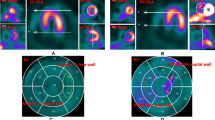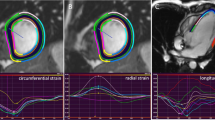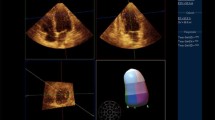Abstract
This study used multi-detector row CT (MDCT) to evaluate the regional geometric parameters of left ventricle (LV) in patients and dogs after right ventricular apical (RVA) pacing. First, we measured and compared the global and regional wall motion parameters derived from MDCT images between three patients post RVA pacing and seven age-matched healthy subjects. The LV ejection fraction (LVEF), LV end-diastolic volume and LV end-systolic volume were measured. We also measured the regional wall thickness, wall thickening and regional wall motion in 12 different segments of the LV. Second, we performed MDCT scan on five dogs as the study group (pacing wire + RVA pacing, 2 months) and four dogs as the sham control group (pacing wire, 2 months). The global and regional geometric parameters were compared within both human and canine groups. Compared with normal subjects, patients post RVA pacing had low LVEF (60.4 ± 10.5 vs. 33.2 ± 17.6, P = 0.014), impaired regional wall thickening and regional wall motion, particularly in segments near the pacing lead. Some segments near the pacing lead were showing dyskinesia after pacing. These findings were successfully reproduced in the canine model. We found that RVA pacing can result in impaired regional wall thickening and regional wall motion, particularly in segments near the pacing lead.



Similar content being viewed by others
References
Tops LF, Schalij MJ, Bax JJ (2009) The effects of right ventricular apical pacing on ventricular function and dyssynchrony implications for therapy. J Am Coll Cardiol 54(9):764–776
Epstein AE, DiMarco JP, Ellenbogen KA et al (2008) ACC/AHA/HRS 2008 Guidelines for Device-Based Therapy of Cardiac Rhythm Abnormalities: a report of the American College of Cardiology/American Heart Association Task Force on Practice Guidelines (Writing Committee to Revise the ACC/AHA/NASPE 2002 Guideline Update for Implantation of Cardiac Pacemakers and Antiarrhythmia Devices) developed in collaboration with the American Association for Thoracic Surgery and Society of Thoracic Surgeons. J Am Coll Cardiol 51(21):e1–e62
Healey JS, Yee R, Tang A (2007) Right ventricular apical pacing: a necessary evil? Curr Opin Cardiol 22(1):33–38
Sweeney MO, Hellkamp AS, Ellenbogen KA et al (2003) Adverse effect of ventricular pacing on heart failure and atrial fibrillation among patients with normal baseline QRS duration in a clinical trial of pacemaker therapy for sinus node dysfunction. Circulation 107(23):2932–2937
Tse HF, Yu C, Wong KK et al (2002) Functional abnormalities in patients with permanent right ventricular pacing: the effect of sites of electrical stimulation. J Am Coll Cardiol 40(8):1451–1458
Tantengco MV, Thomas RL, Karpawich PP (2001) Left ventricular dysfunction after long-term right ventricular apical pacing in the young. J Am Coll Cardiol 37(8):2093–2100
Thambo JB, Bordachar P, Garrigue S et al (2004) Detrimental ventricular remodeling in patients with congenital complete heart block and chronic right ventricular apical pacing. Circulation 110(25):3766–3772
Andersen HR, Nielsen JC, Thomsen PE et al (1997) Long-term follow-up of patients from a randomised trial of atrial versus ventricular pacing for sick-sinus syndrome. Lancet 350(9086):1210–1216
Prinzen FW, Cheriex EC, Delhaas T et al (1995) Asymmetric thickness of the left ventricular wall resulting from asynchronous electric activation: a study in dogs with ventricular pacing and in patients with left bundle branch block. Am Heart J 130(5):1045–1053
van Oosterhout MF, Prinzen FW, Arts T et al (1998) Asynchronous electrical activation induces asymmetrical hypertrophy of the left ventricular wall. Circulation 98(6):588–595
Ten Cate TJ, Van Hemel NM, Verzijlbergen JF (2009) Myocardial perfusion defects in right ventricular apical pacing are caused by partial volume effects because of wall motion abnormalities: a new model to study gated myocardial SPECT with the pacemaker on and off. Nucl Med Commun 30(6):480–484
Boucher CA, Pohost GM, Okada RD et al (1983) Effect of ventricular pacing on left ventricular function assessed by radionuclide angiography. Am Heart J 106(5 Pt 1):1105–1111
Wyman BT, Hunter WC, Prinzen FW et al (1999) Mapping propagation of mechanical activation in the paced heart with MRI tagging. Am J Physiol 276(3 Pt 2):H881–H891
Prinzen FW, Hunter WC, Wyman BT et al (1999) Mapping of regional myocardial strain and work during ventricular pacing: experimental study using magnetic resonance imaging tagging. J Am Coll Cardiol 33(6):1735–1742
Wallerson DC, Devereux RB (1987) Reproducibility of echocardiographic left ventricular measurements. Hypertension 9(2 Pt 2):II6–II18
Luechinger R, Zeijlemaker VA, Pedersen EM et al (2005) In vivo heating of pacemaker leads during magnetic resonance imaging. Eur Heart J 26(4):376–383
Luechinger R, Duru F, Scheidegger MB et al (2001) Force and torque effects of a 1.5-Tesla MRI scanner on cardiac pacemakers and ICDs. Pacing Clin Electrophysiol 24(2):199–205
Hayes DL, Holmes DR Jr, Gray JE (1987) Effect of 1.5 tesla nuclear magnetic resonance imaging scanner on implanted permanent pacemakers. J Am Coll Cardiol 10(4):782–786
Tsai IC, Lee WL, Tsao CR et al (2008) Comprehensive evaluation of ischemic heart disease using MDCT. AJR Am J Roentgenol 191(1):64–72
Schuleri KH, George RT, Lardo AC (2009)Medscape applications of cardiac multidetector CT beyond coronary angiography. Nat Rev Cardiol 6(11):699–710
Lardo AC, Cordeiro MA, Silva C et al (2006) Contrast-enhanced multidetector computed tomography viability imaging after myocardial infarction: characterization of myocyte death, microvascular obstruction, and chronic scar. Circulation 113(3):394–404
Butler J, Shapiro MD, Jassal DS et al (2007) Comparison of multidetector computed tomography and two-dimensional transthoracic echocardiography for left ventricular assessment in patients with heart failure. Am J Cardiol 99(2):247–249
Mahnken AH, Katoh M, Bruners P et al (2005) Acute myocardial infarction: assessment of left ventricular function with 16-detector row spiral CT versus MR imaging—study in pigs. Radiology 236(1):112–117
Ko SM, Kim YJ, Park JH et al (2010) Assessment of left ventricular ejection fraction and regional wall motion with 64-slice multidetector CT: a comparison with two-dimensional transthoracic echocardiography. Br J Radiol 83(985):28–34
Cury RC, Nieman K, Shapiro MD et al (2008) Comprehensive assessment of myocardial perfusion defects, regional wall motion, and left ventricular function by using 64-section multidetector CT. Radiology 248(2):466–475
Tsai IC, Huang YL, Liao WC et al (2009) Left ventricular myocardial volumes measured during arterial and delayed phases of multidetector row computed tomography: a study on intra- and interobserver variability. Int J Cardiovasc Imaging 25(Suppl 1):55–63
Tsai IC, Lin YK, Chang Y et al (2009) Correctness of multi-detector-row computed tomography for diagnosing mechanical prosthetic heart valve disorders using operative findings as a gold standard. Eur Radiol 19(4):857–867
Tsai IC, Hsieh SR, Chern MS et al (2009) Pseudoaneurysm in the left ventricular outflow tract after prosthetic aortic valve implantation: evaluation upon multidetector-row computed tomography. Tex Heart Inst J 36(5):428–432
Lee T, Tsai IC, Fu YC et al (2007) MDCT evaluation after closure of atrial septal defect with an Amplatzer septal occluder. AJR Am J Roentgenol 188(5):W431–W439
Dixon JA, Spinale FG (2009) Large animal models of heart failure: a critical link in the translation of basic science to clinical practice. Circ Heart Fail 2(3):262–271
McCollough C, Cody D, Edyvean S et al. (2008) The measurement, reporting, and management of radiation dose in CT. Am Assoc Physicis Med
Cerqueira MD, Weissman NJ, Dilsizian V et al (2002) Standardized myocardial segmentation and nomenclature for tomographic imaging of the heart. A statement for healthcare professionals from the Cardiac Imaging Committee of the Council on Clinical Cardiology of the American Heart Association. Circulation 105(4):539–542
Acknowledgments
Supported in part by grants from Taichung Veterans General Hospital (TCVGH-973106C, 983105C, 983104B, 975506C, and 985506C), Yen Tjing Lin Medical Foundation (CI 97-12) and the National Science Council (NSC 96-2314-B-075A-011, 97-2314-b-075A-012).
Author information
Authors and Affiliations
Corresponding author
Rights and permissions
About this article
Cite this article
Tsai, IC., Huang, JL., Ueng, KC. et al. Global and regional wall motion abnormalities of pacing-induced heart failure assessed by multi-detector row CT: a patient and canine model study. Int J Cardiovasc Imaging 26 (Suppl 2), 223–235 (2010). https://doi.org/10.1007/s10554-010-9684-2
Received:
Accepted:
Published:
Issue Date:
DOI: https://doi.org/10.1007/s10554-010-9684-2




